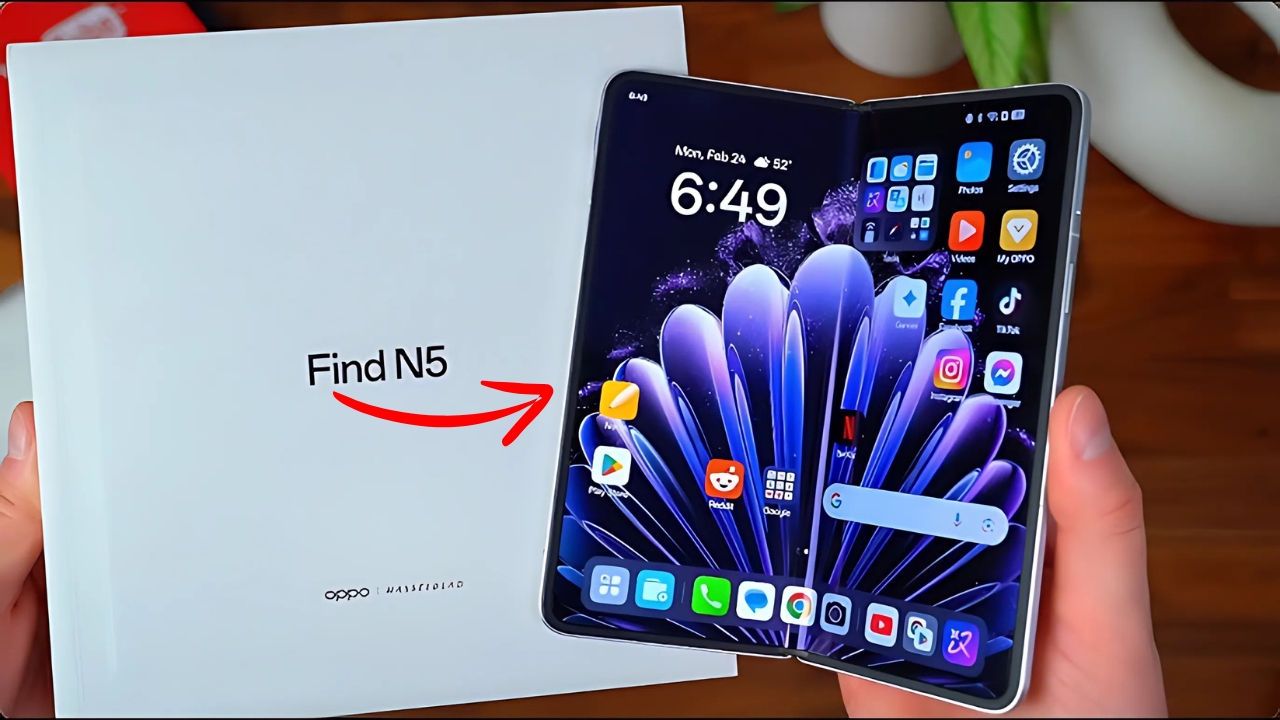Oppo Find N5 : The foldable smartphone market continues to evolve rapidly, with manufacturers competing to create devices that combine innovative technology with practical design.
Oppo, a prominent player in the smartphone industry, has been developing its Find N series to compete with established foldable offerings from Samsung, Xiaomi, and other manufacturers.
The focus on achieving slimmer profiles while maintaining durability represents a significant engineering challenge in this emerging category.
Evolution of Foldable Technology
Foldable smartphones have progressed significantly since their initial introduction. Early models faced criticism for their bulk, weight, and fragility.
Each generation has brought improvements in hinge mechanisms, display technology, and overall design refinement.
The pursuit of thinner profiles has become a key differentiator as manufacturers work to make foldables more pocket-friendly and appealing to mainstream consumers.
The engineering challenges involved in creating slim foldables are substantial.
Manufacturers must balance component placement, battery capacity, cooling systems, and structural integrity while reducing overall thickness.
This requires innovative approaches to internal architecture and careful selection of materials.
Design Philosophy and Engineering
Creating an ultra-slim foldable requires rethinking traditional smartphone design principles.
Engineers must optimize every millimeter of space while ensuring the device remains functional and durable. This involves several key considerations:
The hinge mechanism represents the most critical component, requiring precision engineering to enable smooth folding while minimizing thickness.
Advanced hinge designs use multiple small components working in harmony rather than bulky single mechanisms.
Materials science plays a crucial role, with aerospace-grade alloys and specialized polymers reducing weight without compromising strength.
Display technology has evolved to support thinner profiles. Ultra-thin glass (UTG) and advanced polymer films protect foldable screens while adding minimal thickness.
The challenge lies in maintaining touch sensitivity, visual quality, and durability within these constraints.
Technical Specifications and Features
While specific details about unreleased models remain speculative, modern slim foldables typically incorporate several advanced technologies:
High-refresh-rate AMOLED displays provide smooth visual experiences on both inner and outer screens.
The main foldable display usually ranges from 7.1 to 8 inches, offering tablet-like experiences when unfolded.
Cover displays have grown larger and more functional, enabling full smartphone use without opening the device.
Camera systems in slim foldables face unique packaging challenges. Manufacturers use periscope zoom lenses and computational photography to deliver flagship-level imaging capabilities within space constraints.
Some designs position cameras strategically to serve both folded and unfolded modes effectively.
Processing power comes from flagship-tier chipsets optimized for efficiency.
The latest Snapdragon or MediaTek processors provide performance while managing heat generation in compact spaces.
Memory configurations typically start at 12GB RAM with 256GB storage, catering to power users who expect premium specifications.
Battery and Power Management
Achieving all-day battery life in ultra-slim foldables requires innovative approaches.
Manufacturers often use dual-battery configurations, splitting capacity between the two halves of the device.
This design enables thinner profiles while maintaining adequate power reserves.
Fast charging technology compensates for potentially smaller battery capacities.
Modern foldables support rapid charging speeds exceeding 65W, with some manufacturers pushing toward 100W or higher. Wireless charging integration adds convenience despite space limitations.
Power optimization through software plays an increasingly important role.
Intelligent battery management systems allocate resources based on usage patterns, extending battery life through smart power distribution between displays and processors.
Software Optimization for Foldables
The foldable form factor demands specialized software optimization. Operating systems must seamlessly transition between folded and unfolded states, maintaining app continuity and adjusting layouts appropriately.
Multi-window productivity features take advantage of larger screens, enabling true multitasking capabilities.
App developers increasingly optimize their applications for foldable displays.
Popular productivity apps, creative tools, and entertainment platforms now offer enhanced experiences on larger foldable screens. The ecosystem continues maturing as foldable adoption grows.
Market Position and Competition
The foldable smartphone market remains relatively niche but shows strong growth potential.
Early adopters and technology enthusiasts drive initial sales, while improving designs and falling prices gradually attract mainstream consumers.
Competition intensifies as more manufacturers enter the space with unique approaches.
Price remains a significant factor in foldable adoption. Premium pricing reflects the advanced technology and engineering required, but manufacturers work to reduce costs through scale and technological advancement.
The goal is reaching price points that make foldables accessible to broader audiences.
Durability Considerations
Thin designs must not compromise durability. Modern foldables undergo extensive testing for fold cycles, drop resistance, and environmental protection.
Manufacturers typically rate their hinges for hundreds of thousands of folds, equivalent to years of regular use.
Water and dust resistance in foldables presents unique challenges due to moving parts.
Recent models achieve IPX8 water resistance ratings, protecting against submersion while maintaining slim profiles.
This represents significant engineering achievement given the complexity of foldable designs.
Future Outlook
The future of foldable smartphones appears promising as technology continues advancing.
Expectations include even thinner profiles, improved durability, and new form factors beyond the current book-style and flip designs. Rollable and tri-fold concepts suggest further innovation possibilities.
Battery technology improvements, more efficient processors, and advanced materials will enable future devices to push boundaries further.
The ultimate goal remains creating foldables that match traditional smartphones in portability while offering expanded functionality.
Oppo Find N5 Conclusion
The pursuit of ultra-slim foldable smartphones represents the cutting edge of mobile technology.
While engineering challenges remain substantial, continuous innovation drives the category forward.
As manufacturers refine their approaches and technology matures, foldables may eventually become the preferred form factor for users seeking versatility without compromise.
The competition to create the thinnest, most capable foldable benefits consumers through rapid advancement and expanding choices in this exciting category.
